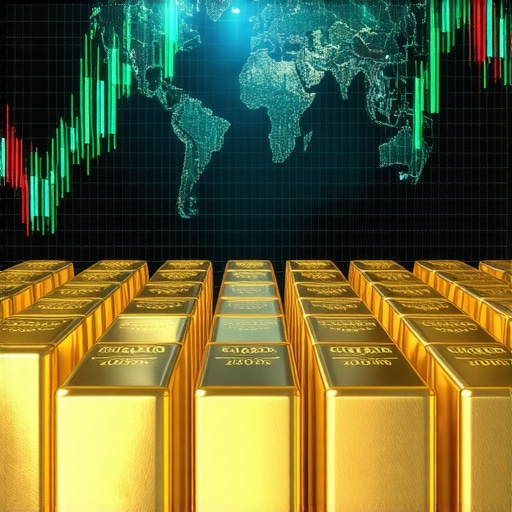Strategic Forecasting: The Evolution of the Gold Market Amid Industry & Consumer Demand Shifts in 2025
As we approach the mid-decade, the gold market stands at a pivotal juncture marked by intricate demand dynamics from industry sectors and evolving consumer preferences. Drawing on extensive industry analysis and macroeconomic indicators, this article explores how these forces will influence gold prices and investment strategies in 2025, demanding a nuanced understanding from investors and industry stakeholders.
Understanding the Macro Drivers Behind Gold Demand in 2025
What macroeconomic factors will predominantly influence gold demand in 2025?
The primary macroeconomic drivers include inflation trajectories, geopolitical stability, and central bank policies. As inflationary pressures persist globally, gold’s role as a hedge becomes increasingly vital, prompting heightened physical and ETF-based investments. Simultaneously, central banks’ gold reserve adjustments—particularly purchases by emerging markets—are expected to significantly impact supply-demand dynamics, as highlighted by recent reports from the World Gold Council.
Industry Demand: Mining, Technology, and Jewelry Sectors in Transition
The industrial sector’s appetite for gold, especially in electronics and renewable energy applications, is anticipated to accelerate due to technological innovations and sustainability commitments. The jewelry industry, however, faces complex challenges related to consumer preferences shifting towards sustainable and ethically sourced materials, which may alter traditional demand patterns. Analyzing these trends reveals critical insights for investors aiming to capitalize on emerging opportunities.
Consumer Preferences and Demand Trends: From Traditional to Digital
Consumer demand is increasingly influenced by digital assets, such as gold-backed cryptocurrencies, and the growing preference for physical gold for wealth preservation. The advent of digital platforms has democratized access to gold investments, thereby expanding the base of investors and altering demand structures. For a comprehensive review of these trends, see smart demand trends.
Forecasting the Future: Price Drivers and Investment Implications for 2025
Multiple price drivers are converging—geopolitical tensions, inflation expectations, and supply constraints—indicating a potentially bullish outlook for gold. Investors should consider diversified strategies, including gold ETFs, physical holdings, and futures, to hedge against volatility. For detailed insights into effective trading strategies, explore gold as a hedge.
Expert Insight: Navigating the Complexities of the 2025 Gold Market
Informed decision-making in 2025 will require a deep understanding of supply-demand fundamentals, macroeconomic signals, and industry-specific innovations. Engaging with comprehensive market analysis and leveraging specialized resources can empower investors to optimize portfolio allocations and capitalize on emerging opportunities within the evolving gold landscape.
For a step-by-step approach to investing in gold, visit gold investment strategies.
Unpacking the Nuances of Gold Supply Chains in 2025
As the global economy navigates unprecedented shifts, understanding the intricacies of gold supply chains becomes paramount for investors seeking to optimize their portfolios. The extraction, processing, and distribution networks are increasingly influenced by geopolitical tensions, technological innovations, and sustainability initiatives. These factors collectively shape the availability and pricing of gold, demanding a sophisticated analysis beyond surface-level metrics.
How will emerging geopolitical conflicts and technological advancements redefine gold supply chain resilience in 2025?
The geopolitical landscape continues to be volatile, with conflicts and trade disputes potentially disrupting traditional supply routes. Conversely, technological breakthroughs, such as automation and blockchain-based traceability, are enhancing transparency and efficiency within the industry. For instance, blockchain applications are enabling real-time tracking of gold from mine to market, reducing fraud and ensuring ethical sourcing—an aspect gaining importance among conscientious investors. To understand the full impact, consult comprehensive industry reports like industry demand insights which analyze these supply chain dynamics.
Market Sentiment and Investor Psychology in 2025
Investor sentiment remains a critical, yet often overlooked, driver of gold prices. Behavioral biases, macroeconomic fears, and media narratives can create volatility that diverges from fundamental supply-demand fundamentals. Recognizing these psychological factors enables investors to avoid herd mentality pitfalls and develop disciplined, data-driven strategies. For example, during periods of heightened uncertainty, gold often acts as a safe haven, but overconfidence in short-term rallies can lead to poor timing decisions. Engaging with expert frameworks like the Market Sentiment Index can provide valuable signals for strategic entry and exit points.
What psychological biases most commonly distort gold investment decisions in 2025, and how can investors mitigate them?
Confirmation bias, loss aversion, and overconfidence are prevalent biases that can cloud judgment. To counteract these, investors should adopt structured decision-making processes, such as setting predefined entry/exit points and diversifying across asset classes, including ETFs and physical gold holdings. For practical tips, explore trading techniques designed for volatile markets.
Harnessing Data Analytics and AI for Smarter Gold Investment
The integration of data analytics and artificial intelligence is transforming how investors interpret market signals. Advanced algorithms analyze vast datasets—from macroeconomic indicators to social media sentiment—delivering predictive insights that were previously unattainable. For example, AI-driven models can forecast gold price movements by analyzing supply chain disruptions, geopolitical events, and investor sentiment in real time. Leveraging these tools can provide a competitive edge, enabling proactive rather than reactive investment strategies. To deepen your understanding, review market analysis frameworks that incorporate AI insights.
Are AI and data analytics becoming essential for successful gold investment in 2025?
Absolutely. As markets grow more complex and information flows accelerate, traditional analysis methods may fall short. Embracing AI-powered analytics allows investors to decode patterns, anticipate market shifts, and refine their strategies continuously. For personalized guidance, consider consulting reputable resources such as market timing techniques tailored to the evolving landscape.
Engagement with these advanced tools and insights not only enhances understanding but also empowers investors to navigate the multifaceted gold market with confidence. Share your thoughts or experiences with AI-driven investment strategies in the comments, or explore more about how to align your portfolio with future market trends through our detailed guides.
Revolutionizing Gold Supply Chains: The Impact of Blockchain and Geopolitical Shifts in 2025
As the global landscape evolves, the resilience of gold supply chains becomes a cornerstone for investors and industry stakeholders alike. Blockchain technology, with its promise of transparency and traceability, is rapidly transforming traditional supply networks. By enabling real-time tracking from mine to market, blockchain diminishes fraud, enhances ethical sourcing, and bolsters confidence among discerning investors. However, geopolitical conflicts, trade disputes, and regulatory hurdles continue to pose significant risks, potentially disrupting supply routes and affecting gold availability.
How do technological innovations like blockchain mitigate supply chain risks amidst geopolitical instability?
Blockchain’s decentralized ledger system creates an immutable record of each transaction, making it significantly more difficult for fraudulent activities or mislabeling to occur. Moreover, smart contracts can automate compliance and quality checks, reducing reliance on intermediary verification processes. According to a comprehensive report by the World Economic Forum (2024), such innovations are crucial for maintaining supply chain integrity, especially when geopolitical tensions threaten conventional logistics. For investors, understanding these technological advancements can inform more resilient portfolio strategies, emphasizing assets linked to transparent supply chains.

Image prompt: Blockchain technology in gold supply chains, showing interconnected digital nodes tracking gold from mine to consumer, high detail, futuristic style.
Emerging Geopolitical Conflicts and Their Effects on Gold Resilience in 2025
Recent geopolitical tensions, including trade disputes and regional conflicts, threaten to destabilize traditional gold supply routes. Countries with significant gold reserves might adopt protective measures, such as increased stockpiling or export restrictions, which could lead to supply shortages and price volatility. Conversely, nations advancing digital infrastructure may leverage blockchain to circumvent some of these disruptions, maintaining steady supply flows. Recognizing these patterns allows investors to anticipate potential market shifts and hedge accordingly.
What strategies can investors employ to safeguard portfolios against geopolitical disruptions in the gold market?
Diversification remains paramount—combining physical gold, ETFs, and futures can mitigate risks associated with supply chain disruptions. Additionally, engaging with suppliers or markets that utilize transparent blockchain networks can reduce exposure to opaque or compromised sources. According to a 2024 analysis by GoldCore, proactive risk management, including scenario planning around geopolitical events, enhances resilience. Investors should stay informed through specialized geopolitical risk assessments and consider integrating AI-driven predictive analytics to identify emerging threats early.
Revolutionizing Gold Supply Chains: The Impact of Blockchain and Geopolitical Shifts in 2025
As the global landscape evolves, the resilience of gold supply chains becomes a cornerstone for investors and industry stakeholders alike. Blockchain technology, with its promise of transparency and traceability, is rapidly transforming traditional supply networks. By enabling real-time tracking from mine to market, blockchain diminishes fraud, enhances ethical sourcing, and bolsters confidence among discerning investors. However, geopolitical conflicts, trade disputes, and regulatory hurdles continue to pose significant risks, potentially disrupting supply routes and affecting gold availability.
How do technological innovations like blockchain mitigate supply chain risks amidst geopolitical instability?
Blockchain’s decentralized ledger system creates an immutable record of each transaction, making it significantly more difficult for fraudulent activities or mislabeling to occur. Moreover, smart contracts can automate compliance and quality checks, reducing reliance on intermediary verification processes. According to a comprehensive report by the World Economic Forum (2024), such innovations are crucial for maintaining supply chain integrity, especially when geopolitical tensions threaten conventional logistics. For investors, understanding these technological advancements can inform more resilient portfolio strategies, emphasizing assets linked to transparent supply chains.

Image prompt: Blockchain technology in gold supply chains, showing interconnected digital nodes tracking gold from mine to consumer, high detail, futuristic style.
Emerging Geopolitical Conflicts and Their Effects on Gold Resilience in 2025
Recent geopolitical tensions, including trade disputes and regional conflicts, threaten to destabilize traditional gold supply routes. Countries with significant gold reserves might adopt protective measures, such as increased stockpiling or export restrictions, which could lead to supply shortages and price volatility. Conversely, nations advancing digital infrastructure may leverage blockchain to circumvent some of these disruptions, maintaining steady supply flows. Recognizing these patterns allows investors to anticipate potential market shifts and hedge accordingly.
What strategies can investors employ to safeguard portfolios against geopolitical disruptions in the gold market?
Diversification remains paramount—combining physical gold, ETFs, and futures can mitigate risks associated with supply chain disruptions. Additionally, engaging with suppliers or markets that utilize transparent blockchain networks can reduce exposure to opaque or compromised sources. According to a 2024 analysis by GoldCore, proactive risk management, including scenario planning around geopolitical events, enhances resilience. Investors should stay informed through specialized geopolitical risk assessments and consider integrating AI-driven predictive analytics to identify emerging threats early.
Expert Insights & Advanced Considerations
1. Diversification is More Crucial Than Ever
In 2025, sophisticated investors recognize that diversifying across physical gold, ETFs, and futures minimizes risks associated with geopolitical and supply chain disruptions, ensuring portfolio resilience amidst volatility.
2. Blockchain Technology Will Be a Market Standard
Blockchain’s role in enhancing transparency and traceability in gold supply chains is no longer optional but essential, reducing fraud and bolstering investor confidence in ethically sourced assets.
3. Macro Trends Will Accelerate Gold’s Safe-Haven Role
Persistent inflation, geopolitical tensions, and central bank policies are reinforcing gold’s position as a strategic hedge, demanding proactive, data-driven investment approaches for 2025.
4. AI and Data Analytics Are Game-Changers
Advanced algorithms analyzing macroeconomic signals, social sentiment, and supply chain disruptions will become indispensable tools for anticipating price movements and optimizing entry and exit points in gold investments.
5. Geopolitical Risks Require Dynamic Portfolio Management
Investors must adopt scenario planning and leverage AI-driven predictive analytics to navigate geopolitical conflicts that threaten to disrupt supply chains and impact prices significantly.
Curated Expert Resources
- World Gold Council Reports: Authoritative data and analysis on global gold demand, supply trends, and central bank activities.
- World Economic Forum Publications: Insights on blockchain innovations and supply chain resilience in the mining industry.
- Financial Times and Bloomberg: Up-to-date news and expert commentaries on geopolitical developments affecting gold markets.
- Academic Journals on Commodity Markets: Research papers on AI applications and predictive analytics in the gold industry.
- Specialized Investment Platforms: Advanced tools for scenario analysis, risk management, and portfolio optimization tailored for gold investors.
Final Expert Perspective
As gold continues to evolve into a complex, technology-driven asset class, understanding the interplay of macroeconomic forces, supply chain innovations, and investor psychology is vital for success in 2025. Embracing advanced analytics, blockchain transparency, and diversified strategies will enable discerning investors to navigate this landscape with confidence. Engage deeply with authoritative resources, stay informed on geopolitical shifts, and leverage cutting-edge tools—your strategic edge in the gold market awaits. For further insights, explore market analysis frameworks that incorporate these emerging trends.










